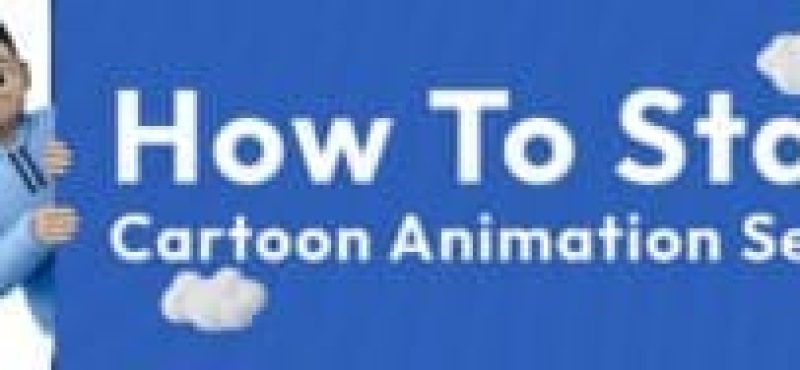Did you watch something like Bojack Horseman and have your brain drive you to creating something similar? If you are thinking about starting your own cartoon animation series but have no idea how, consider this blog your holy grail!
Creating your own 3D cartoon animation series is pretty hectic and can leave you wondering how to start cartoon animation series of your own. It could be possible that your team is full of creative animators but you don’t have a good enough story. Or maybe you’ve started off well but your project is at a standstill because of insufficient funds.
There are many things that you need to keep in mind when it comes to starting your own animated series production. Feel free to read on and use this blog as a checklist of things to keep in mind when you start your animation project.
SETTING YOUR CARTOON ANIMATION SERIES IN PRE-PRODUCTION
Creating cartoon 3D animation doesn’t mean that you start creating characters and animation them right away. A lot goes into the process of creating a cartoon animation series. So, don’t rush in blind. Make sure you set the stage right with a good pre-production phase.
#1 BUDGET
Alright, let’s talk about money! Before you dive headfirst into your cartoon animation series, you obviously need to sort out the budget stuff. Let’s say you have this awesome idea for a cartoon, but didn’t plan the budget properly? You will run out of cash halfway through production, and your animated characters will end up looking like stick figures on a sugar rush. Don’t do that!
Animation can burn a hole in your pocket faster than you can say “cartoons.” So, get your calculator out and start crunching those numbers. Think about every step of the process, from the initial concept to the final marketing push.

#2 STORYLINE
Alright, you’ve got your piggy bank ready to roll. Now it’s time to cook up an out-of-this-world storyline. Imagine you had an “Eureka!” moment for a cartoon series. You got started on the character modelling and even ended animating a 15 second sequence. But what next? You don’t know how to proceed with the storyline and your project has started to get a little boring.
This is why you need a scriptwriter to help you write a story for your cartoon animation series. The story of your animation series needs to have viewers hitched from the first scene. Moreover, writing down a script will also help you decide on the theme of your story which could be horror, comedy, or even a tear jerker!
#3 CONCEPT ART AND STORYBOARDING
Before you get started on the production there is one more thing to keep in mind. Create a storyboard to outline the flow of your series, scene by scene. It’s basically like sketching a comic book version of your episodes. And don’t forget about concept art! Draw your characters, settings, and key moments to give your team a sneak peek into the amazing project they will be working on.
Let’s say you are pitching your cartoon to potential investors. Reading a script could be boring but when you show them your concept art and storyboards, they can practically see your story leaping off the pages.

JUMPING ONTO THE PRODUCTION PHASE
Now that the base is all strong, you can move forward to creating your cartoon animation series. This includes stages like character modelling, animation and voiceover. By the end of this stage, you will have a proper episode that showcases your story and just needs a little tweaking by the end.
#1 3D CHARACTER MODELLING
Alright, it is time to bring your characters to life! Character modelling is like giving your cartoon characters a digital copy. Now a lot goes into creating a character model. You’ve got to ensure that the features of the character’s face showcase their personality.
Moreover, all characters should be in the same art style. You can’t really create one character that looks super realistic while the other looks like a nursery rhyme character. So, to make sure this process goes smoothly, hire a character artist who can sculpt your ideas into something fans will adore.
#2 ANIMATION STAGE
Now this is where the real action happens. Your characters will start moving, grooving, and following the story you’ve created! Whether you’re going for 2D or 3D animation, make sure the movement matches your storytelling style.
However, you must be aware of the fact that animation is no child’s play. Countless cups of coffee and late-night animation sessions are a normal thing when it comes to bringing your characters to life with natural movements. So, you need to hire a big team of animators to make sure that all of your scenes are animated on time.
#3 MUSIC AND VOICEOVER
Music is the secret ingredient that adds a whole new dimension to storytelling in cartoon animations. A catchy tune can become the anthem of your animated series, resonating with viewers long after they’ve finished watching. So, when it comes to music, finding the right composer for animations is key to unleashing the full potential of your creation.
Oh, and how could we forget the voice overs that bring your animated characters to life? Just like the right music, the perfect voice can work wonders in immersing your audience in the world you’ve created. A talented voiceover artist can infuse your characters with personality, quirks, and emotions, making them feel like real, relatable beings.

ENDING THINGS IN THE POST PRODUCTION PHASE
Once you’ve pushed out the final render of your animation series, it is time to process it to the post-production phase. This is where the final touches are added, and your animated masterpiece becomes more pretty to look at. In one way, this phase is like the icing on the cake, enhancing the visual and auditory elements of your cartoon to perfection.
#1 VISUAL EFFECTS
In this digital era, visual effects (VFX) are the secret sauce that adds a dash of magic and realism to your animated series. From epic explosions to fantastical environments, VFX takes your animation to new heights.
Talented VFX artists work their skills, creating mind-blowing effects that seamlessly blend with your animation. Whether your characters are soaring through the skies or navigating a mystical realm, Visual Effects brings a sense of awe and wonder to every scene.
#2 COLOUR GRADING
Colour grading is like the painter’s final strokes on the canvas. It sets the mood and tone of your cartoon, giving it a distinct visual style. The right colour palette can evoke emotions, create atmosphere, and make your animation pop off the screen.
With careful colour grading, your animation can go from a pleasant experience to an unforgettable visual feast. Whether it’s a vibrant, lively palette for a comedy series or a moody, subdued one for a dark and mysterious tale, colour grading amplifies the storytelling power of your animation.
BRINGING OUT YOUR CARTOON ANIMATION SERIES TO THE WORLD
Now that your animated series is polished and ready to make its mark on the world, it’s time to tackle the critical phase of distribution and marketing. After all, what’s the point of creating something incredible if no one gets to see it?Take in mind these tips on strategic distribution and marketing before you release your animated series.
- Know Your Target Audience: First things first, identify your target audience. Who would love your cartoon the most? Is it kids, teenagers, adults, or a specific niche? Understanding your audience’s preferences, interests, and online behaviour will help you tailor your distribution and marketing efforts more effectively.
- Choose the Right Distribution Channels: Consider the platforms where your target audience hangs out the most. Is it YouTube, Vimeo, streaming services, or social media platforms like Instagram and TikTok? Each platform has its strengths and audience demographics, so choose the ones that align with your cartoon’s style and target audience.
- Create a Trailer or Teaser: Craft a captivating trailer or teaser that showcases the best moments of your animated series. A well-made trailer can generate excitement, curiosity, and anticipation among your potential viewers. Use it as a sneak peek that leaves them eagerly waiting for the full release.
- Leverage Social Media: Social media is a powerful tool for connecting with your audience and promoting your animated series. Create engaging posts, behind-the-scenes content, character art, and interactive quizzes to keep your audience engaged and excited about your cartoon.
- Participate in Animation Festivals and Events: Submit your animated series to animation festivals and events. It’s an excellent way to showcase your work to industry professionals, potential partners, and animation enthusiasts. Winning awards or receiving recognition can create buzz around your series.
- Consider Licensing and Syndication:Explore opportunities for licensing your animated series to other platforms, broadcasters, or streaming services. Syndicating your content can expand its reach and bring in additional revenue streams.
YOU ARE ALL SET TO START YOUR CARTOON ANIMATION SERIES
Now that you’ve gone through this blog, you are pretty much enlightened with tips on how to start your animation series. Now, there are chances that you might not have a specific dedicated team for each of these tasks. That shouldn’t stop you from creating your cartoon series.
You could either hire an animation studio or outsource animation or any other related service from an animation outsourcing company. If you want to know more about how to hire an animation company or the top 10 animation companies in India, feel free to read our blogs.

FAQ’S
Key considerations include budgeting, storyline development, character modeling, animation, voiceovers, post-production elements like visual effects and color grading, as well as distribution and marketing strategies.
Proper budgeting ensures that the production process can proceed smoothly without running out of funds halfway through. It helps avoid compromising the quality of the animation due to financial constraints.
A scriptwriter helps develop engaging storylines that captivate viewers from the first scene. They also define the theme of the series, whether it’s horror, comedy, or drama, and provide direction for character development and plot progression.
Concept art and storyboarding help visualize the flow of the series and provide a sneak peek into the project for potential investors. They serve as blueprints for the animation team, guiding the creation of characters, settings, and key moments.
Social media platforms can be used to connect with the target audience, share behind-the-scenes content, showcase character art, and create interactive quizzes to engage viewers. Additionally, platforms like YouTube, Vimeo, and TikTok can serve as distribution channels for the series.




